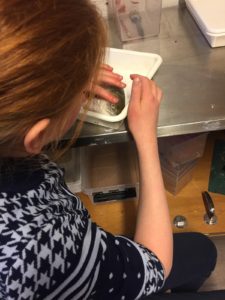Welcome to Unit 2 Experiencing STEAM: What if one of our senses changed?
On this page we will review some key resources from the Experiencing STEAM team on the theme of animal senses, which we hope will give you inspiration to plan a relevant lesson with your own learners.
After you have reviewed these materials click on Mark Complete at the bottom of this page to continue.
Case study and lesson plan
Idea to Explore
An interesting way to learn about senses is to examine how different animals use their senses and how their senses relate to ours.
Some humans also have over-sensitive senses and this has a permanent effect on their lives.
How would our lives change if our senses changed or if we were able to bioengineer our senses?
Introductory video
Methodology
The sections below – Discover, Define, Develop and Deliver – aligns to the design thinking model:

Discover
In the discovery phase, we discussed both animal and human senses with the pupils: Which senses do we have? How do they work?
Many animals use their senses in a different way than we do. For example, dogs have an ability to hear and smell far better than humans; bats have an ability to catch insects without being able to see; elephants have an ability to use low frequency infrasounds to communicate between herds far apart.
The video above illustrates an owl’s extraordinary sense of hearing as it responds to a hidden phone making the sound of a squeaking vole.
Next, the pupils experimented with their own senses, such as by being blindfolded or by wearing noise cancelling ear protection. We discussed the results and shared the conclusions with our partner class.
Define
We examined how fish use their senses by looking at blind cavefish and trout. The teacher explained how fish use the lateral line system of sense organs to detect movement, vibration and pressure changes in the water around them. The pupils dissected a rainbow trout to examine the lateral line system, the eyes and the brain. In groups, the pupils took photos, made videos and macro-pictures, wrote conclusions about the rainbow trout and the products were uploaded to eTwinning for sharing.

Following this, the pupils experimented with the orientation skills of cavefish by designing a simple labyrinth for a live cavefish. The blind fish followed a stick that was vibrated a few centimetres away from the fish. The fish senses the vibration, assumes it is food and hence follows the stick.
Develop
We discussed how the fish was able to find its way through the labyrinth, and the pupils created a video recording explaining the lateral system and how the blind cave fish used it to navigate around.
We also looked at humans whose senses are more sensitive than usual. The pupils imagined how their life would be different if one of their senses changed. They used visual arts, videos and photography to describe these new opportunities or disadvantages.
An idea is to invite someone to the school to tell how changed senses affect their life and think about how loss of a sense affects other senses and how the human brain adapts to these changes through a characteristic known as neuroplasticity. For example, visually impaired people may compensate with improved hearing. Classes could swap video interviews explaining the reasons for the changed sense and how it affects peoples lives.
Deliver
The pupils shared videos describing the lateral line systems of fish, and explaining the senses and super senses of humans and animals.
International Collaboration
During our project day, the two classes in Denmark and Norway worked with different aspects of the senses. The Danish team explored senses by dissecting fish and experimenting with the blind cave fish, and the Norwegian team interviewed a person with super sensitive senses. These findings were recorded on video and edited by the students and sent to the opposite country with a research problem to solve. Additionally, we had a Skype call between the classes. The art products created by the students were shared on eTwinning.
Resources Needed
- Tablets or phones for taking pictures and shooting and editing a video.
- Dissecting equipment (scalpel, tweezers, dissection bowl).
- Equipment for measuring the speed of sound.
- A macro camera or the macro settings on an iPad or Android device.
- Apps: Tone generator, Decibel X noise meter.
STEM to STEAM analysis
Science: Senses. How do different animals use their senses and how do they compare with human senses? Dissection of a fish, exploring the fish sense system and finding various organs. Humans with super senses – experiments with human senses.
Technology: Macro-photography of details from fish sense system; macro photography of the iris of the human eye; labyrinth for observing lateral line system of the cavefish; using video recording and editing tools to create a video for the partner school/class.
Engineering: Designing a labyrinth that works for studying the lateral line system of the blind cavefish
Art: Students find a creative solution to help humans with super sensitive senses by using, visual arts and film. For example, students used macro pictures and photography techniques to visualise their life with super senses or with a lack of a sense.
Mathematics: In connection with the theme of super senses, pupils considered probabilities, calculated the speed of sound, carried out decibel calculations and examined the diffusion-time of particles through the air.
Padlet – Ideas
Below is a Padlet of examples to help you to think about how you could develop this theme in your own teaching context.
You can open the Padlet in a new tab if you prefer: https://padlet.com/dlaberasmus/Unit2ExperiencingSTEAMWhatifwelostorgainedasense
After you have reviewed these materials click on Mark Complete at the bottom of this page to continue.
